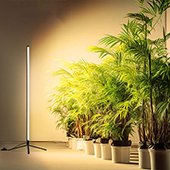Menu
What Color Grow Light is Best for Indoor Plants?
Your favorite ferns stretch gracefully in the radiant light, your herbaceous plants thrive in the dance of technological hues, and your orchids bloom with vibrant colors—all thanks to the magic of grow lights. It has completely transformed the way we nurture indoor plants.
However, a question arises in this indoor garden: what color of light is most crucial for our plants? Is it the sunset’s fiery red, the summer sky’s cool azure, or the mysterious blend of colors in a rainbow?
The secret to the joyful growth of indoor plants is not just a magical color. The key lies in understanding how light promotes plant growth, much like the role of sunlight in an outdoor garden.
This post will decrypt it for you, unveiling the mystery behind the colors of grow lights and helping you find the perfect light formula for your indoor oasis.
Table of Contents
Exploring the Rainbow of Lighting
Photosynthesis is the magical process of converting sunlight into plant fuel, akin to a tiny biochemical engine humming within each leaf. Under the right light, the humming of this engine is at its loudest, and this is precisely where the mystery of our rainbow begins.
Perfectly Balanced PAR
Imagine light as a buffet for plants. Just as not all dishes are the same, and humans don’t survive on desserts alone, plants need a balanced “diet” of light wavelengths. This is where PAR, or Photosynthetically Active Radiation, comes into play.
PAR refers to specific light wavelengths (mainly blue and red) that plants can digest and convert into delicious sugars.
When choosing grow lights, it’s like selecting the right menu for your leafy friends.
Blue Light (400-520 nanometers)
Blue light stimulates leaf growth, strengthens stems, and promotes chlorophyll production. Chlorophyll is a green pigment that gives plants their lush green color! Think of a dense, vibrant jungle with flourishing leaves—that’s the power of blue light.
Red Light (630-660 nanometers)
Picture succulent berries and thriving flowers—that’s the magic of red light. It triggers flowering, promotes fruit development, and keeps plants overall healthy and happy. Imagine a field of sunflowers basking in sunlight—that’s the sunshine brought by red light.
Green Light (500-570 nanometers)
While green light doesn’t directly promote photosynthesis, its impact on plants is relatively small. However, it helps regulate the plant’s growth cycle and contributes to overall health.
Beyond the Rainbow
The light show doesn’t stop here! Some grow lights provide ultraviolet wavelengths to help plants resist pests and diseases. Others may include a variety of colors, offering a comprehensive “full-spectrum” buffet for plants.

Spectrum Tailored to Different Plant Needs
Now that we’ve cracked the light code, let’s explore how to tailor the color spectrum to your plant’s specific needs, like a culinary chef crafting the perfect dish!
Vegetative Growth (Leafy Plants)
Imagine spinach reaching for the sky, kale unfurling its emerald waves, and basil bursting with aromatic leaves. Blue light is the master gardener for these leafy wonders.
Between 400-520 nm, it acts like a tiny architect, encouraging strong stems, branching, and vibrant foliage. Think of it as building the sturdy foundation of your leafy forest.
But here’s a secret ingredient: a touch of red light (630-660 nm) can add some magic.
Not too much, just a gentle brushstroke, can promote overall growth and keep your leafy greens nice and compact.
Yes, blue light builds the leafy towers, and red light adds the finishing touches for a lush, healthy jungle.
Flowering & Fruiting
Remember those vibrant cherry blossoms bursting in spring, the intoxicating scent of summer roses, and the juicy bounty of autumn?
Between 630-660 nm, the red light acts like a love potion, whispering sweet nothings to your plants, urging them to unleash their floral fire and fruity passion.
Think of the red light as the backstage director, cueing the grand entrance of petals and fruit. It tells your plants it’s time to put on a show, igniting the hormones that trigger bud formation, fruit development, and all the juicy, colorful drama in between.
Every plant is unique, with its light preferences.
Tomato: Give your tomato plants a generous dose of red light for bountiful harvests. Consider adding a touch of orange light for extra juicy fruits.
Pepper: If you’re craving capsicums, red light is still your best friend, but give far-red light a try to kickstart the flowering show.
Strawberry: Red and orange light are the star actors for these sweet treats, but some varieties might appreciate a subtle hint of blue light to encourage leaf growth and support fruit production.
By understanding the language of light and catering to your plants’ individual needs, you can turn your indoor garden into a stage for dazzling floral displays and bountiful fruit harvests.
Seedling Growth
Seedlings also require the perfect lighting formula to thrive—soft, balanced light. The harmonious combination of red and blue light is crucial to aid in the growth of seedlings.
Blue light is the architect in the plant world, guiding the upward growth of stems, promoting branching, and facilitating the healthy development of leaves. It’s like laying a solid foundation for their future growth.
Red light, on the other hand, adds a touch of magic to plants. It stimulates root growth, enhances their immune systems, and helps them lay a solid foundation for flowering and fruiting in the future.
Some might argue that white or full-spectrum light is the ultimate food for seedlings, offering a buffet of all the colors they need.
This rainbow blend can be a great option, providing all the essential wavelengths for healthy development.
But balance is key. Too much red light at this stage can lead to leggy growth, while too much blue can stunt their progress.
Here’s the secret recipe for seedling success:
Blue Light: Aim for 40-50% of your total light spectrum. This will keep your little sprouts reaching for the sky and building strong leaves.
Red Light: Keep it around 30-40%. This will fuel their root growth and overall health, without pushing them to bloom too early.
White or Full Spectrum: If you’re using these lights, monitor your seedlings closely. Adjust the height and intensity to ensure they receive enough blue and not too much red.
Remember, these are just guidelines. Experiment, observe your tiny green friends, and adjust the light recipe to their specific needs.
Choosing the Right Grow Light
Now that we’ve cracked the color code of plant light, it’s time to choose the right tools for the job!
But beware, adventurers, not all grow lights are created equal. Let’s explore the different options and find the perfect lighting.
Incandescent and Fluorescent Lights
Remember grandma’s incandescent bulbs, bathing your childhood home in a warm glow? While nostalgic, these fiery orbs aren’t the best choice for your plant friends.
They emit a lot of heat, wasting energy and potentially scorching your leafy companions. Their light spectrum isn’t optimal for photosynthesis, leaving your plants craving the right wavelengths.
Fluorescent lights offer a slightly kinder touch, but they still come with limitations. While emitting less heat, their PAR (Photosynthetically Active Radiation) output is often weak, and their spectrum may not be concentrated enough for optimal plant growth.
Think of them as the dimly lit side streets of the grow light world – helpful in a pinch, but not illuminating the full potential of your botanical wonders.
LED Grow Lights
LED plant growth lights are the shining stars in the realm of jungle illumination, inviting us to step into the future. Vibrant blue and red LEDs in LED plant lights directly provide the light plants need, making photosynthesis a breeze.
Forget about bulky light bulbs and scorching high temperatures—LED lights operate cool, with extremely low energy consumption, making them eco-conscious guardians of the jungle.
Moreover, their long lifespan, lasting for several years, can save you expenses in the long run. It’s like having a tireless team of gardeners, tirelessly providing nutrition to your green friends 24/7!
Not all LED heroes are created equal. Here’s a quick guide to navigating the different types:
Red and Blue LED Bars: These basic warriors are perfect for budget-conscious growers. They deliver a focused punch of blue and red light, ideal for leafy greens and vegetative growth.
Full-Spectrum LEDs: Think of these as the rainbow rangers, offering a blend of all the essential wavelengths. They’re great for versatile use, supporting all stages of plant growth and even encouraging flowering.
Customizable LEDs: For the advanced plant whisperers, there are adjustable LED panels that let you fine-tune the light spectrum to your plants’ specific needs. Want extra-juicy tomatoes? Crank up the red! Need vibrant leafy greens? Dial up the blue!
We are a LED grow light manufacturer, dedicated to providing a variety of plant lights for both home growers and professional cultivators.
Whether you’re looking to replace outdated incandescent and fluorescent lights with innovative LED grow lights or require specific custom services, feel free to contact us for the latest information on LED grow lighting.
Get in touch with us!
From custom light planning, to tailored quotes, and everything in between, our team of horticulture experts are always ready to assist.




